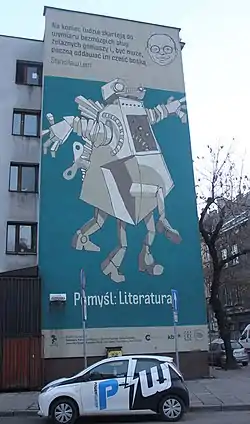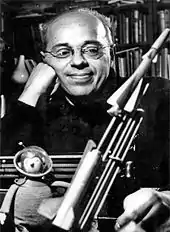
Robotic life is a frequent topic in the works of self-described "futurologist" Stanisław Lem. Robots are most heavily featured in Lem's Fables for Robots (1964), a collection of satirical fairy tales set in a universe populated entirely by robots, with robot kings, robot peasants, robot knights, and robot scientists; a robot damsel in distress is pestered by a robot dragon, robot dogs have robot fleas, etc.[1] The collection The Cyberiad (1965) belongs to the same grotesque cross-genre of fairy tale and science fiction. Its main protagonists are robots-"constructors" Trurl and Klapaucius, who are something of both sorcerers and engineers.[2]
Robots of different kind are major characters in several stories from Lem's Tales of Pirx the Pilot cycle, as well as in some occasional stories, such as The Mask. [3][2]
An ultimate evolution of military robotics is described in the novel The Invincible, where a human crew is defeated by a swarm of microrobots evolved by natural selection in the course of wars waged by robots. The idea was pursued by Lem further in his fictitious review "Weapon Systems of the Twenty First Century or The Upside-down Evolution".[4]
Bibliography
- "The Hunt" (1950s Stanisław Lem short story)
- "Faithful Robot", (1961), a comedy/mystery/drama science fiction TV play
- In the 1963 short story "Tragedia pralnicza" ("Washer Tragedy") from the memoirs of Ijon Tichy (Ze wspomnień Ijona Tichego), a rat race of the competition among washing machine manufacturers, Nuddlegg and Snodgrass corporations construct progressively smarter washer robots, which gradually acquire wider and wider legal rights as intelligent entities, [5] which leads to all kinds of legal perplexities.[6]
- The Invincible (1964)
- "The Sanatorium of Dr. Vliperdius" ["Zakład doktora Vliperdiusa"] (1964, translated into English in the collection Mortal Engines), about a mental asylum for robots
- A fabular universe of robots
- Fables for Robots (1964)
- The Cyberiad (1965)
- "The Mask"
- From the Tales of Pirx the Pilot:
- "The Accident"
- "The Inquest"; for plot summary, see Inquest of Pilot Pirx, a 1978 film
- "Terminus"
- "The Hunt" (different from the 1950s story)
Lem also wrote about intelligent machines other than robots
- Golem XIV, a lecture course given by a superintelligent computer
- Summa Technologiae (1964), a book-length essay contains Chapter 4: "Intellectronics", a term coined by Lem to speculate on the field that is known today as artificial intelligence, in lieu of the term "cybernetics" banned in the Soviet Bloc.
In popular culture
A mural in Kraków depicts a typical grotesque fabular robot, with a quotation from Dialogs: "Eventually the humans will dwarf down to the level of brainless servants of iron geniuses and may be even start to worship them as Gods". The mural was created by Filip Kużniarz in 2012. [7]
An elaborate interactive robot-themed Google Doodle inspired by The Cyberiad was created for the 60th anniversary of Lem's first published book: The Astronauts.[8][9][10][11]
References
- ↑ An introduction to the 1992 edition of the Mortal Engines (ISBN 0156621614), a collection of translations, whose bulk consisting of Lem's Fables...
- 1 2 Jerzy Jarzębski, "Stanisław Lem, Rationalist and Visionary", Science Fiction Studies, vil. 4, part 2, issue 12, 1977, pp.110–125
- ↑ Dominika Oramus, "The Uncanny Robots of Plot Pirx: Stanisław Lem's Tales", Interlitteraria, vol. 21, no. 1, 2016, 143-157
- ↑ "CAŁY TEN ZŁOM" an afterword to The Invincible by Jerzy Jarzębski
- ↑ "Tragedia pralnicza", at Lem's official website
- ↑ "Stanisław Lem - Mensch, Denker, Schriftsteller : Beiträge einer deutsch-polnischen Konferenz im Jahr 2000 in Greifswald und Szczecin", 2005, ISBN 3447051477, p.121
- ↑ "Kraków’s Street Art: A Walk Through History, Creativity & Profound Thought", culture.pl, September 12, 2018
- ↑ "Stanisław Lem on Google’s homepage", an interview of Lem doodle creators, Marcin Wichary and Sophia Foster-Dimino
- ↑ "Case Study: Building the Stanisław Lem Google doodle", by Marcin Wichary, one of the LEM doodle developers
- ↑ "Stanisław Lem doodle". Retrieved 2013-09-13.
- ↑ "Google creates doodle in Stanislaw Lem's book". The Guardian. 23 November 2011. Retrieved 23 November 2011.
Further reading
- Jo Alyson Parker, "Gendering the Robot: Stanislaw Lem’s 'The Mask' ", Science Fiction Studies, No. 57, Volume 19, Part 2, July 1992
- John Rothfork, "The Ghost in the Machine: The Concept of Self in Stanislaw Lem's Mortal Engines", Liberal and Fine Arts Review, vol. 4, no.1, 1984, pp. 1-18
